What does SPF stand for?
"Sun Protection Factor." It is a measure of how effectively a sunscreen product will protect your skin from the harmful effects of ultraviolet (UV) B rays. The SPF number indicates the level of protection the sunscreen provides against sunburn caused by UVB radiation. The higher the SPF number, the greater the level of protection. For example, SPF 15 filters out approximately 93% of UVB rays, while SPF 30 filters out about 97%, and SPF 50 filters out about 98%. It's important to note that SPF primarily measures protection against UVB rays, and it's advisable to use broad-spectrum sunscreens that also protect against UVA rays for comprehensive sun protection.
How does Sunblock work?
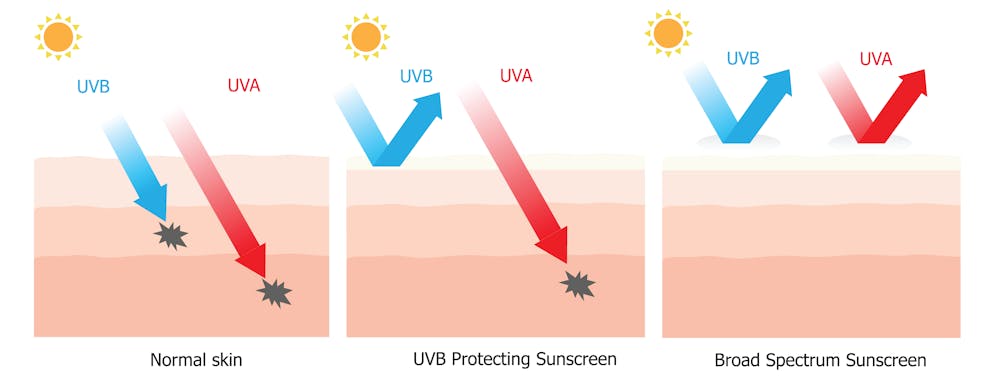
Sunblock, or sunscreen, works by providing a protective barrier on the skin that helps to absorb, reflect, or scatter the sun's ultraviolet (UV) radiation. UV radiation from the sun comes in two main types: UVA and UVB. Both UVA and UVB rays can cause damage to the skin, including sunburn, premature aging, and an increased risk of skin cancer.
Here's how sunblock works:
-
Chemical Filters:
- Many sunscreens contain organic or chemical filters, such as avobenzone, octocrylene, or octinoxate. These compounds absorb UV radiation and transform it into heat, which is then released from the skin.
-
Physical or Mineral Filters:
- Sunscreens may also contain physical or mineral filters, such as zinc oxide or titanium dioxide. These ingredients act as a physical barrier on the skin, reflecting and scattering UV radiation away from the skin's surface.
-
Broad-Spectrum Protection:
- A good sunscreen often provides broad-spectrum protection, meaning it guards against both UVA and UVB rays. UVA rays are associated with premature aging, while UVB rays are responsible for sunburn.
-
SPF (Sun Protection Factor):
- The SPF number on a sunscreen indicates its effectiveness in protecting against UVB rays. For example, SPF 30 means that the sunscreen filters out approximately 97% of UVB rays, while SPF 50 filters out about 98%.
-
Reapplication:
- Sunscreen effectiveness diminishes over time, especially with exposure to water or sweat. It's crucial to reapply sunscreen every two hours or more frequently if swimming or sweating.
Applying sunscreen correctly and consistently is essential for optimal protection against the harmful effects of UV radiation. It is recommended to apply sunscreen generously to all exposed skin, even on cloudy days, and to use additional protective measures like wearing hats, sunglasses, and seeking shade when possible.
How often should I reapply sunscreen?

The frequency of sunscreen reapplication depends on various factors, including the sunscreen's water resistance, your activities, and the amount you initially applied. In general, it's recommended to reapply sunscreen:
-
Every Two Hours:
- If you are staying outdoors for an extended period, it's advisable to reapply sunscreen every two hours. This helps maintain effective protection, especially if you are sweating or engaging in water activities.
-
After Swimming or Sweating:
- If you go swimming or engage in activities that cause you to sweat heavily, reapply sunscreen more frequently, even if the product claims to be water-resistant. Water-resistant sunscreens provide protection for a specific duration (usually 40 or 80 minutes), after which reapplication is necessary.
-
Follow Product Instructions:
- Always follow the specific instructions on the sunscreen product you are using. Some sunscreens may have different recommendations based on their formulation and intended use.
-
Applying Generously:
- Ensure you apply sunscreen generously to all exposed skin. Using too little can reduce the effectiveness of the product. As a general guideline, most adults need about one ounce (30 milliliters) of sunscreen to cover their entire body.
-
During Prolonged Sun Exposure:
- If you are spending an extended period in direct sunlight, consider reapplying more frequently, especially if you have fair skin or are prone to sunburn.
Remember that even on cloudy days, UV rays can penetrate clouds and cause skin damage, so it's a good practice to wear sunscreen regardless of the weather. Additionally, consider using other sun protection measures such as wearing protective clothing, seeking shade, and wearing sunglasses.
Can I use expired sunscreen?

Using expired sunscreen is generally not recommended. Sunscreen has an expiration date for a reason – the active ingredients in the product may become less effective over time. The stability of these ingredients can be affected by factors such as exposure to heat, light, and air.
Here are some reasons why using expired sunscreen may not provide adequate protection:
-
Decreased Effectiveness:
- Over time, the active ingredients in sunscreen, such as UV filters, can degrade. This degradation reduces the effectiveness of the sunscreen in protecting your skin from harmful UV radiation.
-
Unreliable SPF:
- The sun protection factor (SPF) listed on the expired sunscreen may no longer be accurate. The product may not provide the level of protection indicated on the label.
-
Risk of Sunburn:
- Using expired sunscreen may increase the risk of sunburn and other skin damage, as the product may not offer the intended level of protection.
To ensure proper sun protection, it's advisable to check the expiration date on the sunscreen packaging and replace it if it has passed. Additionally, if the sunscreen has changed in color, consistency, or has an unusual smell, it's best to discard it, as these may be signs of deterioration.
To maximize the effectiveness of your sunscreen, store it in a cool, dry place, and avoid exposing it to extreme temperatures or direct sunlight. If you are unsure about the safety or efficacy of a sunscreen, it's always better to err on the side of caution and purchase a new, unexpired product.
What is the difference between UVA and UVB rays?

UVA (Ultraviolet A) and UVB (Ultraviolet B) are two types of ultraviolet radiation from the sun, and they differ in terms of their wavelengths and the ways they affect the skin.
-
Wavelength:
- UVA: UVA rays have longer wavelengths (320 to 400 nanometers). They penetrate the skin more deeply than UVB rays and are associated with premature aging.
- UVB: UVB rays have shorter wavelengths (280 to 320 nanometers). They affect the outer layer of the skin and are primarily responsible for causing sunburn.
-
Penetration:
- UVA: UVA rays penetrate the skin more deeply, reaching the dermis, where they can cause long-term damage such as wrinkles and loss of elasticity. UVA rays are present throughout the day and can penetrate clouds and glass.
- UVB: UVB rays mostly affect the outer layer of the skin (epidermis) and are the primary cause of sunburn. UVB rays are more intense during midday and can be partially blocked by clouds and glass.
-
Skin Effects:
- UVA: UVA exposure contributes to premature aging, leading to wrinkles, fine lines, and age spots. UVA rays are also associated with some skin cancers.
- UVB: UVB exposure is the main cause of sunburn and plays a key role in the development of skin cancer, including melanoma.
-
Tanning Response:
- UVA: UVA rays contribute to tanning by oxidizing existing melanin in the skin, leading to immediate color change.
- UVB: UVB rays stimulate the production of new melanin, leading to delayed tanning that becomes evident a day or two after sun exposure.
It's important to note that both UVA and UVB rays can contribute to skin cancer, and protection against both types of radiation is crucial. When selecting a sunscreen, it's recommended to choose a broad-spectrum sunscreen that provides protection against both UVA and UVB rays. This helps to prevent sunburn, premature aging, and reduces the risk of skin cancer.
Is sunscreen safe for sensitive skin?
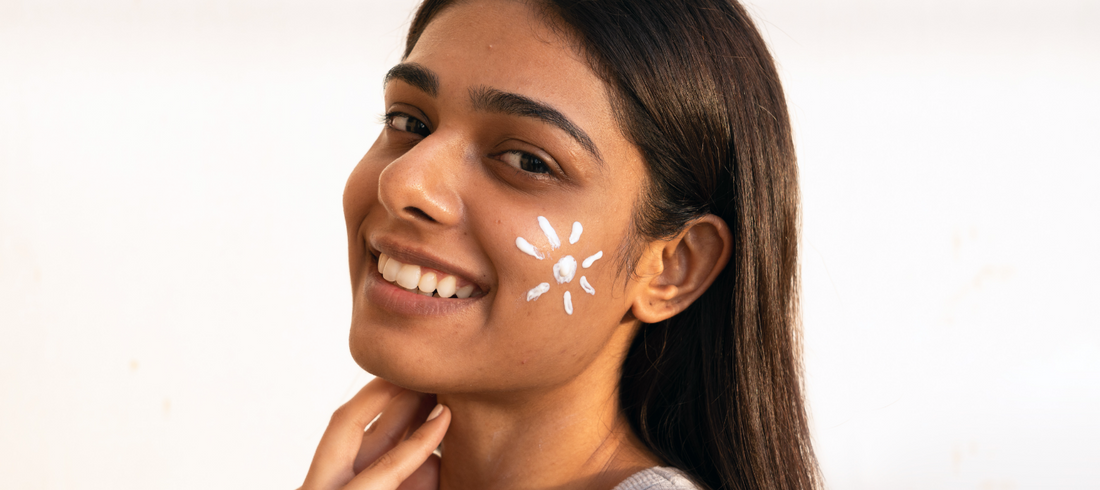
Sunscreen is generally safe for sensitive skin, but individuals with sensitive skin may be more prone to irritation from certain sunscreen ingredients. It's important to choose sunscreens specifically labeled as "hypoallergenic" or "designed for sensitive skin." Here are some tips for selecting and using sunscreen for sensitive skin:
-
Choose Physical (Mineral) Sunscreens:
- Physical or mineral sunscreens contain active ingredients like zinc oxide or titanium dioxide, which sit on the skin's surface and provide a physical barrier against UV rays. These are often better tolerated by sensitive skin compared to chemical sunscreens.
-
Look for Fragrance-Free Formulas:
- Fragrances in sunscreen can sometimes cause irritation for those with sensitive skin. Opt for sunscreens labeled as "fragrance-free" or "sensitive skin" to minimize the risk of irritation.
-
Check for Hypoallergenic Claims:
- Sunscreens labeled as hypoallergenic are formulated to minimize the risk of allergic reactions. Look for products with this designation to reduce the likelihood of skin sensitivity.
-
Avoid Harsh Chemicals:
- Check the ingredient list for potential irritants such as oxybenzone, avobenzone, and octocrylene. Some individuals with sensitive skin may find these chemical filters irritating.
-
Patch Test New Products:
- Before applying a new sunscreen to your entire body, conduct a patch test on a small area of skin to check for any adverse reactions.
-
Choose Water-Based Formulas:
- Water-based or gel-based sunscreens are often lighter and less likely to clog pores, making them suitable for sensitive or acne-prone skin.
-
Consult a Dermatologist:
- If you have specific concerns or skin conditions, it's advisable to consult with a dermatologist. They can provide personalized recommendations based on your skin type and any existing skin issues.
Remember to apply sunscreen generously and reapply it as recommended, especially if you are spending extended periods outdoors. If you experience any irritation or adverse reactions, discontinue use and consult with a healthcare professional or dermatologist.
What is the best SPF for my skin?

The choice of Sun Protection Factor (SPF) for your sunscreen depends on various factors, including your skin type, the intensity of sun exposure, and any specific skin conditions you may have. Here are some general guidelines to help you choose the appropriate SPF:
-
Fair Skin vs. Dark Skin:
- Fair or light skin tends to burn more easily, so individuals with lighter skin tones may benefit from higher SPF levels (30 or above). Darker skin tones are less prone to sunburn but can still be damaged by UV rays, so an SPF 15 to 30 may be suitable.
-
Sun Exposure Conditions:
- If you are spending a prolonged period in direct sunlight, participating in water activities, or at higher altitudes, consider using a higher SPF to provide extra protection.
-
Personal Sun Sensitivity:
- If you have a history of sunburns or are more sensitive to the sun, opting for a higher SPF is a good idea.
-
Daily Activities:
- For everyday activities with limited sun exposure, such as commuting to work or running errands, an SPF of 15 to 30 may be sufficient. If you spend more time outdoors, especially during peak sunlight hours, consider a higher SPF.
-
SPF Ratings:
- SPF 15 provides about 93% protection against UVB rays.
- SPF 30 provides about 97% protection.
- SPF 50 provides about 98% protection.
- SPF 100 provides about 99% protection.
It's important to note that no sunscreen provides 100% protection, and reapplication is crucial, especially after swimming or sweating.
-
Skin Conditions:
- If you have certain skin conditions, such as a history of skin cancer or photosensitivity disorders, your dermatologist may recommend a higher SPF for added protection.
Ultimately, it's advisable to choose a broad-spectrum sunscreen that protects against both UVA and UVB rays. Additionally, consistency in application, regardless of the SPF level, is key to effective sun protection. If you have specific concerns or questions about the best SPF for your skin, it's recommended to consult with a dermatologist for personalized advice.
Should I wear sunscreen on cloudy days?
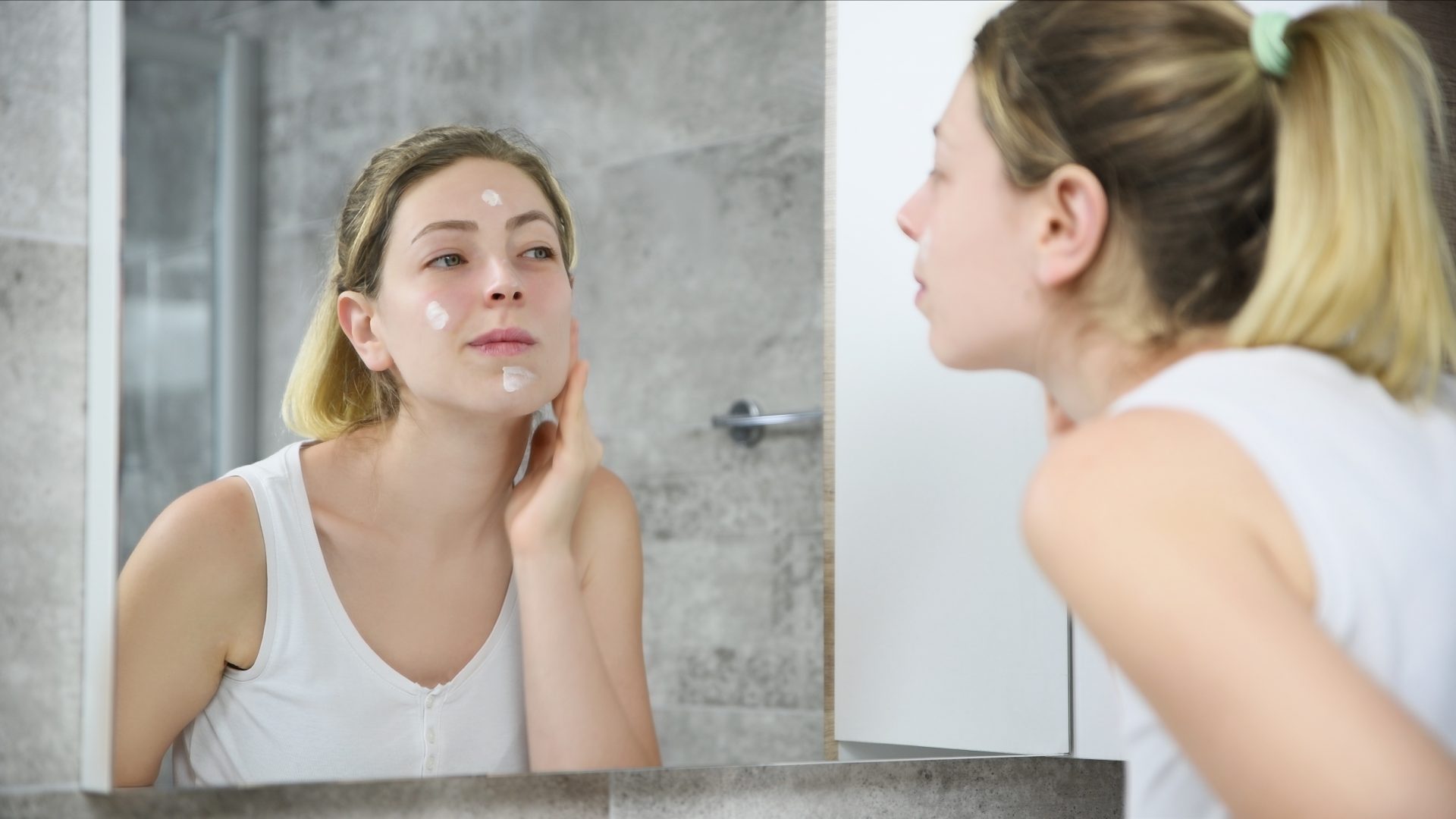
Yes, you should wear sunscreen on cloudy days as well. While clouds may block some of the sun's visible light, they do not necessarily block the ultraviolet (UV) rays that can cause skin damage. Both UVA and UVB rays can penetrate through clouds, and prolonged exposure can lead to sunburn, premature aging, and an increased risk of skin cancer.
Here are a few reasons why wearing sunscreen on cloudy days is important:
-
UV Radiation Penetration:
- UV radiation can penetrate through clouds, meaning that even on overcast days, your skin is still exposed to potentially harmful rays.
-
UVA Damage:
- UVA rays, which are associated with premature aging and can contribute to skin cancer, are present throughout the day and can penetrate clouds and glass.
-
Consistent Protection:
- Wearing sunscreen consistently, regardless of the weather, helps maintain a routine of sun protection. UV rays can cause cumulative damage over time, and regular sunscreen use is crucial for long-term skin health.
-
Reflection from Surfaces:
- UV rays can reflect off surfaces such as water, sand, and snow. Even on cloudy days, if you are near reflective surfaces, you may be exposed to indirect UV radiation.
-
Prevention of Sunburn:
- Sunburn can occur even on cloudy days, especially if you spend extended periods outdoors. Sunscreen helps prevent sunburn and reduces the risk of skin damage.
When choosing a sunscreen for cloudy days, select a broad-spectrum sunscreen with a sufficient SPF level for your skin type. Additionally, it's important to apply sunscreen to all exposed skin and reapply it every two hours or more frequently if you are swimming or sweating. Don't forget areas that are often overlooked, such as the ears, neck, and the back of your hands.
Can I wear makeup over sunscreen?

Yes, you can absolutely wear makeup over sunscreen. In fact, it's a good practice to include sunscreen as a crucial step in your skincare routine, even before applying makeup. Here are some tips for incorporating sunscreen and makeup:
-
Apply Sunscreen First:
- Start with a broad-spectrum sunscreen with at least SPF 30. Apply it as the first step in your skincare routine, before any makeup. Allow the sunscreen to be absorbed into the skin before moving on to makeup application.
-
Wait for Absorption:
- It's advisable to wait a few minutes after applying sunscreen to allow it to fully absorb into the skin. This ensures that the sunscreen forms a protective barrier.
-
Use Makeup with SPF:
- Consider using makeup products that also contain SPF for an additional layer of sun protection. However, keep in mind that relying solely on makeup for sun protection may not provide adequate coverage, so it's essential to use a dedicated sunscreen underneath.
-
Apply Makeup Normally:
- Once the sunscreen has been absorbed, proceed with your regular makeup routine. Sunscreen should not interfere with the application of foundation, concealer, or other makeup products.
-
Reapply Sunscreen Throughout the Day:
- Sunscreen needs to be reapplied every two hours, especially if you are spending extended periods outdoors or if you've been sweating. Reapplying sunscreen over makeup can be challenging, so it's a good idea to use other sun protection measures, such as seeking shade and wearing a wide-brimmed hat.
-
Consider Powder Sunscreen:
- If you need to reapply sunscreen over makeup, consider using a powder sunscreen. These products often come in a brush-on or compact form and can be applied over makeup without disrupting it.
Remember that the effectiveness of sunscreen is crucial for protecting your skin from the harmful effects of UV rays. Regularly reapplying sunscreen, even when wearing makeup, is key to maintaining sun protection throughout the day.
Are there natural alternatives to sunscreen?

While some natural ingredients may offer limited sun protection, they are generally not as reliable or effective as commercially available sunscreens. Sunscreen products are specifically formulated to provide broad-spectrum protection against both UVA and UVB rays, and they undergo rigorous testing to ensure their efficacy. Natural alternatives may have lower sun protection factors (SPF) and may not offer sufficient protection against harmful UV radiation.
However, if you're looking for additional ways to support sun protection naturally, you can consider the following:
-
Clothing:
- Wearing clothing that covers your skin is one of the most effective natural ways to protect against UV radiation. Choose lightweight, tightly woven fabrics and dark colors for better protection.
-
Hats:
- Wide-brimmed hats can provide shade to your face, neck, and shoulders, offering an additional layer of protection against the sun.
-
Sunglasses:
- Sunglasses with UV protection help shield your eyes from harmful UV rays and can prevent damage to the delicate skin around your eyes.
-
Seek Shade:
- Avoid direct sunlight during peak hours (usually between 10 a.m. and 4 p.m.). Whenever possible, seek shade under trees, umbrellas, or other structures.
-
Antioxidant-Rich Diet:
- Consuming a diet rich in antioxidants from fruits and vegetables may help support your skin's natural defense against UV damage.
-
Coconut Oil and Shea Butter:
- While these natural ingredients may offer some moisturizing benefits, their SPF is generally low. They should not be relied upon as the sole form of sun protection but can be used as additional moisture after applying sunscreen.
It's crucial to note that relying solely on natural alternatives may not provide adequate protection against the harmful effects of UV radiation. The American Academy of Dermatology and other health organizations recommend using a broad-spectrum sunscreen with at least SPF 30 for effective sun protection. If you have concerns about the chemicals in traditional sunscreens, consider exploring mineral sunscreens, which use physical blockers like zinc oxide or titanium dioxide and are generally well-tolerated by many individuals. Always consult with a healthcare professional or dermatologist for personalized advice on sun protection based on your skin type and lifestyle.
How much sunscreen should I apply?

The amount of sunscreen you should apply is crucial for ensuring effective protection against the sun's harmful ultraviolet (UV) rays. In general, most people do not apply enough sunscreen, leading to a reduction in the product's effectiveness. Here are some guidelines for how much sunscreen to apply:
-
Follow the Two-Milligram Rule:
- The American Academy of Dermatology recommends applying at least two milligrams of sunscreen per square centimeter of skin. This translates to about one ounce (30 milliliters) of sunscreen for an average adult body. This amount is enough to cover the body if you are wearing a swimsuit.
-
Use the Teaspoon Rule for Face and Neck:
- For the face and neck, the "teaspoon rule" can be helpful. Apply about one teaspoon of sunscreen to the face and an additional teaspoon for the neck.
-
Cover All Exposed Skin:
- Make sure to apply sunscreen to all exposed skin, including the ears, neck, hands, and the tops of your feet. Don't forget often overlooked areas like the back of the neck and the part in your hair.
-
Apply Before Sun Exposure:
- Apply sunscreen 15 to 30 minutes before sun exposure to allow it to be absorbed into the skin properly.
-
Reapply Every Two Hours:
- Sunscreen effectiveness diminishes over time, especially with exposure to water or sweating. Reapply sunscreen at least every two hours, or more frequently if swimming or sweating.
-
Use More for Larger Body Sizes:
- If you have a larger body size, you may need more sunscreen to ensure proper coverage. Adjust the amount accordingly to cover all exposed skin adequately.
Remember that applying too little sunscreen reduces its effectiveness, so it's better to err on the side of using a bit more than too little. Additionally, consider using a lip balm with SPF to protect your lips.
For optimal sun protection, choose a broad-spectrum sunscreen with at least SPF 30, and be consistent in applying and reapplying throughout the day, especially during extended periods of sun exposure.
Do I need sunscreen indoors?
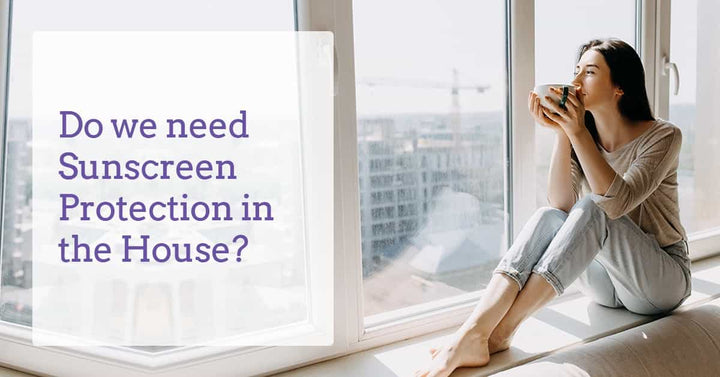
In general, you don't need sunscreen indoors, as the walls and windows of buildings provide some protection against the sun's ultraviolet (UV) rays. However, there are certain situations where sun protection may still be necessary indoors:
-
Direct Sunlight Exposure:
- If you spend a significant amount of time near windows where direct sunlight enters, you may be exposed to UV rays. This is particularly relevant for people who work near windows or spend extended periods sitting by them.
-
UVA Radiation:
- UVA rays, which contribute to premature aging and can penetrate glass, may still reach your skin indoors. If you have a concern about photoaging, you may consider using sunscreen on exposed areas.
-
Photodermatoses and Photosensitivity:
- Some individuals have conditions that make their skin more sensitive to light (photosensitivity or photodermatoses). In such cases, dermatologists may recommend sun protection, even indoors, to prevent flare-ups or worsening of skin conditions.
-
UV Exposure from Electronic Devices:
- Extended use of electronic devices with screens (phones, computers, etc.) may expose the skin to low levels of UV radiation. While the risk is generally minimal, some individuals use sunscreens or skincare products with added protection if they spend long hours in front of screens.
In most cases, if you are indoors and not directly exposed to sunlight, you may not need to apply sunscreen. However, it's essential to maintain good sun protection habits when you spend extended periods outdoors or near windows receiving direct sunlight. Additionally, incorporating other sun protection measures such as wearing protective clothing, using sunglasses, and seeking shade when possible can further reduce UV exposure.
Can I use body sunscreen on my face?

While it's generally safe to use body sunscreen on your face, there are a few considerations to keep in mind:
-
Ingredients:
- Body sunscreens may contain ingredients that are safe for the body but could be potentially irritating to the more sensitive skin on the face. The skin on the face is thinner and more prone to reactions, so it's essential to check the ingredients.
-
Fragrance:
- Body sunscreens may have added fragrances that can be irritating to facial skin, especially if you have sensitive skin or are prone to allergies. Consider choosing a sunscreen labeled as "face sunscreen" or "for sensitive skin" if fragrance is a concern.
-
Texture:
- Body sunscreens may have a thicker or greasier texture, which may not be ideal for the more delicate skin on the face. Facial sunscreens are often formulated to be lighter and more suitable for daily use.
-
Non-comedogenic Formulas:
- If you have acne-prone skin, look for sunscreens labeled as "non-comedogenic" to reduce the risk of clogging pores and causing breakouts.
-
SPF Level:
- Ensure that the body sunscreen has an appropriate Sun Protection Factor (SPF) for facial use. It's recommended to use a sunscreen with at least SPF 30 for daily protection.
While you can use body sunscreen on your face in a pinch, it's often more beneficial to choose a sunscreen specifically formulated for the face. Facial sunscreens are designed to address the unique needs of facial skin, including its sensitivity and the desire for a lightweight, non-greasy feel. They are also more likely to be labeled as non-comedogenic.
When applying sunscreen to the face, be sure to cover all exposed areas, including the neck and ears. Additionally, don't forget to reapply throughout the day, especially if you're sweating or spending extended periods outdoors.
What is water-resistant sunscreen?
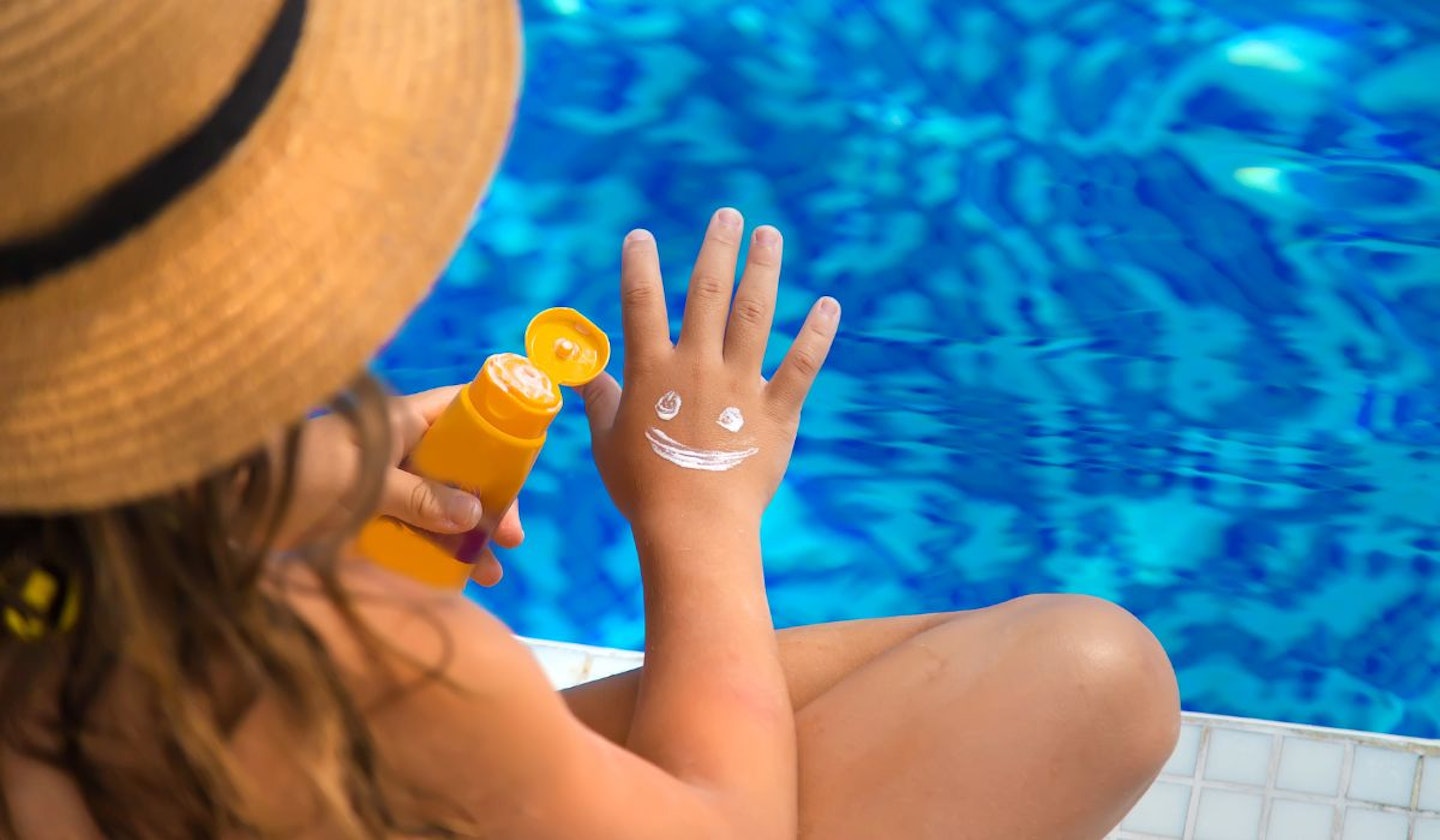
Water-resistant sunscreen is a type of sunscreen formulated to provide protection even when the skin is exposed to water through activities such as swimming or sweating. The term "water-resistant" refers to the sunscreen's ability to maintain its effectiveness after exposure to water for a specified period.
There are two standardized water resistance claims for sunscreens:
-
Water-Resistant (40 Minutes):
- Sunscreens labeled as "water-resistant (40 minutes)" have been tested and demonstrated to provide protection after 40 minutes of water exposure. After that time, it is advisable to reapply the sunscreen for continued protection.
-
Very Water-Resistant (80 Minutes):
- Sunscreens labeled as "very water-resistant (80 minutes)" have been tested and shown to maintain their effectiveness even after 80 minutes of water exposure. Like the 40-minute water-resistant sunscreen, reapplication is recommended after 80 minutes of water activity.
It's important to note that water-resistant sunscreen does not mean waterproof, and it does not provide indefinite protection in water. Factors such as swimming, sweating, and towel-drying can gradually reduce the effectiveness of the sunscreen, making reapplication necessary.
When using water-resistant sunscreen:
- Follow Instructions: Always follow the product's instructions for reapplication, especially after water exposure.
- Reapply Regularly: Even if you're not in the water, reapply sunscreen every two hours or more frequently if you're sweating.
- Choose the Right SPF: Select a water-resistant sunscreen with a Sun Protection Factor (SPF) suitable for your skin type and the intensity of sun exposure.
Water-resistant sunscreens are particularly useful for individuals who engage in water activities or vigorous outdoor sports. However, consistent and proper application, as well as reapplication, are key to maintaining effective sun protection.
Is sunscreen safe for children?
Yes, sunscreen is generally considered safe for children when used as directed. In fact, protecting children's skin from the sun is crucial for preventing sunburn and reducing the risk of long-term skin damage, including skin cancer. Here are some guidelines for using sunscreen on children:
-
Choose a Sunscreen Specifically for Children:
- Look for sunscreens labeled as safe for children or formulated for kids. These sunscreens are often designed to be gentler on a child's sensitive skin.
-
Select a Broad-Spectrum Sunscreen:
- Choose a broad-spectrum sunscreen that provides protection against both UVA and UVB rays.
-
Use a Minimum SPF of 30:
- Select a sunscreen with a Sun Protection Factor (SPF) of at least 30. Higher SPFs can provide additional protection, but proper application and reapplication are essential regardless of the SPF.
-
Avoid Sunscreens with Harsh Chemicals:
- Opt for sunscreens with gentle formulations that are less likely to cause irritation. Avoid sunscreens containing oxybenzone and octinoxate, especially for younger children, as some studies suggest potential concerns with these ingredients.
-
Apply Sunscreen 15-30 Minutes Before Sun Exposure:
- Apply sunscreen to all exposed skin at least 15-30 minutes before sun exposure. Make sure to cover areas like the face, ears, neck, and any other exposed skin.
-
Reapply Sunscreen Every Two Hours:
- Reapply sunscreen at least every two hours, or more frequently if your child is swimming or sweating. Even water-resistant sunscreens lose their effectiveness over time.
-
Protective Clothing:
- In addition to sunscreen, dress children in protective clothing, including hats, sunglasses, and lightweight, long-sleeved shirts and pants.
-
Keep Infants Out of Direct Sunlight:
- For infants under six months old, it's generally recommended to keep them out of direct sunlight and to use protective clothing and shade rather than relying on sunscreen.
If your child has specific skin conditions or allergies, it's a good idea to consult with a pediatrician or dermatologist before choosing a sunscreen. Additionally, perform a patch test before applying a new sunscreen to check for any adverse reactions.
Remember that instilling good sun protection habits early in life can contribute to a lower risk of skin damage and skin cancer later in life.
Can I apply sunscreen on tattoos?

Yes, it's important to apply sunscreen on tattoos to protect them from the sun's harmful ultraviolet (UV) rays. Sun exposure can lead to fading and damage to tattooed skin. Here are some guidelines for applying sunscreen on tattoos:
-
Choose a Broad-Spectrum Sunscreen:
- Select a broad-spectrum sunscreen that provides protection against both UVA and UVB rays. This ensures comprehensive coverage for your tattoo.
-
Use a Sunscreen with High SPF:
- Opt for a sunscreen with a Sun Protection Factor (SPF) of at least 30. Higher SPFs can offer additional protection, but proper application and reapplication are key.
-
Apply Sunscreen Before Sun Exposure:
- Apply sunscreen to your tattooed skin at least 15-30 minutes before sun exposure. This allows the sunscreen to be absorbed and provides optimal protection.
-
Reapply Sunscreen Regularly:
- Reapply sunscreen every two hours, or more frequently if you are swimming, sweating, or engaging in activities that may rub or wash off the sunscreen.
-
Cover the Entire Tattooed Area:
- Ensure that the sunscreen covers the entire tattooed area, including any exposed edges. Don't forget to apply sunscreen on surrounding skin as well.
-
Protect Your Tattoo from Direct Sunlight:
- Whenever possible, protect your tattoo from direct sunlight by wearing protective clothing, seeking shade, or using accessories like hats and umbrellas.
-
Avoid Tanning Beds:
- Tanning beds can also cause fading and damage to tattoos, so it's advisable to avoid them if you want to preserve the vibrancy of your ink.
-
Moisturize Regularly:
- Keep your tattooed skin moisturized regularly to maintain the health and appearance of the tattoo. Healthy skin is better equipped to retain the ink.
Proper sun protection helps preserve the color and details of your tattoos, preventing them from fading or becoming distorted over time. If you have recently gotten a new tattoo, it's crucial to follow the aftercare instructions provided by your tattoo artist, which may include recommendations for sunscreen application during the healing.
What are the common ingredients in sunscreen?
Sunscreen formulations may contain a variety of active and inactive ingredients, and the specific components can vary between different products. The active ingredients in sunscreen are responsible for blocking or absorbing ultraviolet (UV) radiation, while inactive ingredients contribute to the product's texture, stability, and overall performance. Here are some common ingredients found in sunscreens:
Active Ingredients:
-
Chemical (Organic) Filters:
- These absorb UV radiation.
- Common examples include:
- Avobenzone
- Octocrylene
- Octinoxate (Octylmethoxycinnamate)
- Homosalate
- Oxybenzone
-
Physical (Inorganic or Mineral) Filters:
- These reflect and scatter UV radiation.
- Common examples include:
- Zinc oxide
- Titanium dioxide
Inactive Ingredients:
-
Emollients and Moisturizers:
- These help keep the skin hydrated.
- Common examples include:
- Glycerin
- Dimethicone
- Lanolin
- Shea butter
-
Emulsifiers:
- These help mix oil and water components in the formulation.
- Common examples include:
- Cetyl alcohol
- Stearyl alcohol
-
Preservatives:
- These prevent the growth of bacteria and fungi in the sunscreen.
- Common examples include:
- Parabens
- Phenoxyethanol
-
Fragrances:
- Some sunscreens may contain added fragrances for a pleasant scent.
- Fragrance-free options are available for those with sensitive skin.
-
Antioxidants:
- These may be included to help neutralize free radicals generated by UV exposure.
- Common examples include:
- Vitamin E (tocopherol)
- Vitamin C (ascorbic acid)
- Green tea extract
-
Thickeners and Stabilizers:
- These help maintain the sunscreen's texture and stability.
- Common examples include:
- Xanthan gum
- Carbomer
It's important to note that some people may be sensitive or allergic to certain sunscreen ingredients. If you have specific skin concerns or sensitivities, consider choosing a sunscreen labeled as "hypoallergenic" or consulting with a dermatologist to find a suitable product for your skin type. Additionally, mineral sunscreens with zinc oxide or titanium dioxide are often recommended for those with sensitive skin, as they are less likely to cause irritation.
How long does it take for sunscreen to start working?
:max_bytes(150000):strip_icc()/moisturizer-or-sunscreen-first-GettyImages-1412486543-a6946d81eb654570b729fffa23b3e8ce.jpg)
Sunscreen typically takes about 15 to 30 minutes to start working after it's applied to the skin. This time frame is known as the "absorption time" and allows the active ingredients in the sunscreen to be absorbed into the skin and form a protective barrier.
Here are some key points about the absorption time of sunscreen:
-
Apply Before Sun Exposure:
- To ensure optimal protection, it's recommended to apply sunscreen 15 to 30 minutes before sun exposure. This allows the product to be absorbed and provides a sufficient amount of time for it to start working.
-
Sunscreen Activation:
- The active ingredients in sunscreen, whether chemical or physical filters, need time to bind to the skin and form a protective layer. This layer helps to absorb, reflect, or scatter the ultraviolet (UV) radiation from the sun.
-
Reapplication:
- After the initial application, it's important to reapply sunscreen every two hours or more frequently if swimming or sweating. Reapplication helps maintain the effectiveness of the sunscreen, especially during prolonged sun exposure.
-
Effective Sun Protection:
- Sunscreen is most effective when used as part of a comprehensive sun protection strategy, which may include seeking shade, wearing protective clothing, and using sunglasses. Sunscreen alone is not a guarantee of full protection.
-
Water-Resistant Sunscreen:
- If you're planning to be in the water or sweating, consider using a water-resistant sunscreen. Water-resistant sunscreens are formulated to maintain their effectiveness after exposure to water for a specified period, such as 40 or 80 minutes.
It's essential to follow the specific instructions provided on the sunscreen product you are using, as formulations may vary. Additionally, the Sun Protection Factor (SPF) of the sunscreen indicates its level of protection against UVB rays, and using a broad-spectrum sunscreen is recommended to protect against both UVA and UVB rays.
Can I use sunscreen on dark skin?
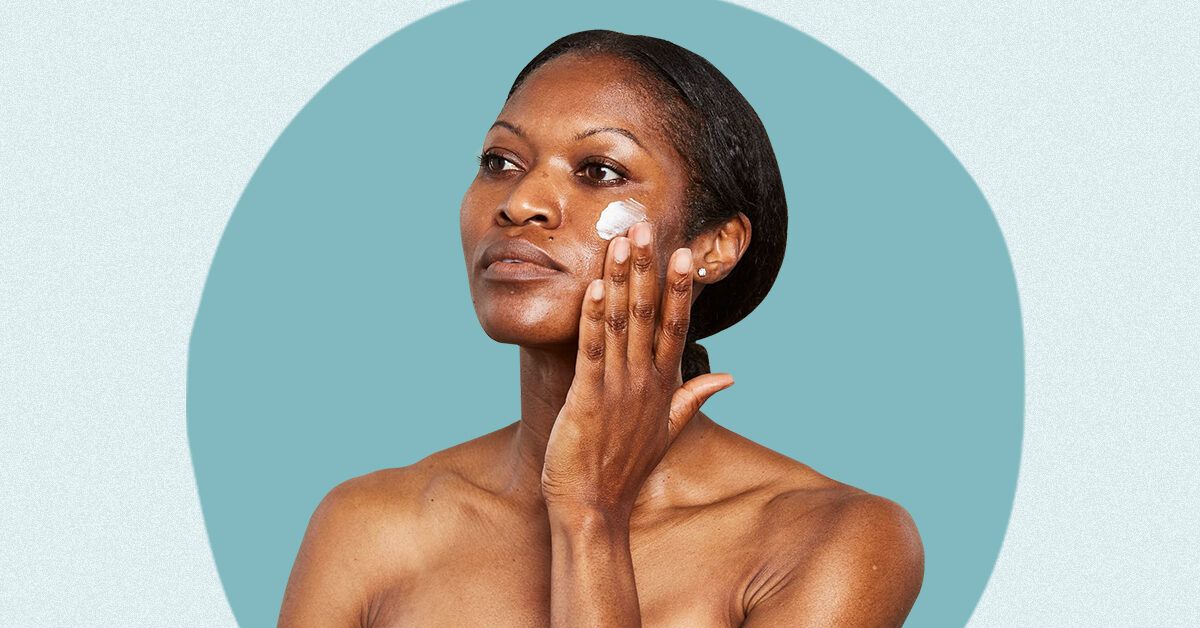
Yes, absolutely! Sunscreen is important for individuals with all skin types, including those with dark skin. While people with darker skin tones naturally have more melanin, which provides some inherent protection against UV radiation, they are still at risk of sun damage, including sunburn, premature aging, and an increased risk of skin cancer. Here are some key points about using sunscreen on dark skin:
-
Protection Against Skin Cancer:
- Dark skin does provide some protection against UV radiation, but it doesn't eliminate the risk of skin cancer. Sunscreen helps protect against both UVA and UVB rays, reducing the risk of skin damage and skin cancer.
-
Prevention of Hyperpigmentation:
- Sunscreen is crucial for preventing hyperpigmentation and uneven skin tone in individuals with dark skin. Sun exposure can lead to the development or exacerbation of dark spots and discoloration.
-
Anti-Aging Benefits:
- Sunscreen helps prevent premature aging caused by sun exposure. This includes the development of fine lines, wrinkles, and loss of skin elasticity.
-
Use of Broad-Spectrum Sunscreen:
- Choose a broad-spectrum sunscreen that provides protection against both UVA and UVB rays. This ensures comprehensive coverage against different types of UV radiation.
-
Consider Tinted Sunscreens:
- Tinted sunscreens may be suitable for individuals with darker skin tones as they can help avoid the white residue that some traditional sunscreens may leave on the skin.
-
Choose a Suitable SPF:
- While individuals with darker skin may have a lower risk of sunburn, it's still important to use an appropriate Sun Protection Factor (SPF). An SPF of 30 or higher is generally recommended.
-
Regular Application and Reapplication:
- Apply sunscreen generously to all exposed skin and reapply it every two hours or more frequently if swimming or sweating.
-
Include Sun Protection in Your Routine:
- Make sunscreen a consistent part of your daily skincare routine, even on cloudy days, as UV rays can penetrate clouds.
Remember that everyone, regardless of skin tone, can benefit from sun protection. If you have specific skincare concerns or conditions, consider consulting with a dermatologist for personalized advice on sun protection and skincare.
How does sunscreen prevent skin cancer?
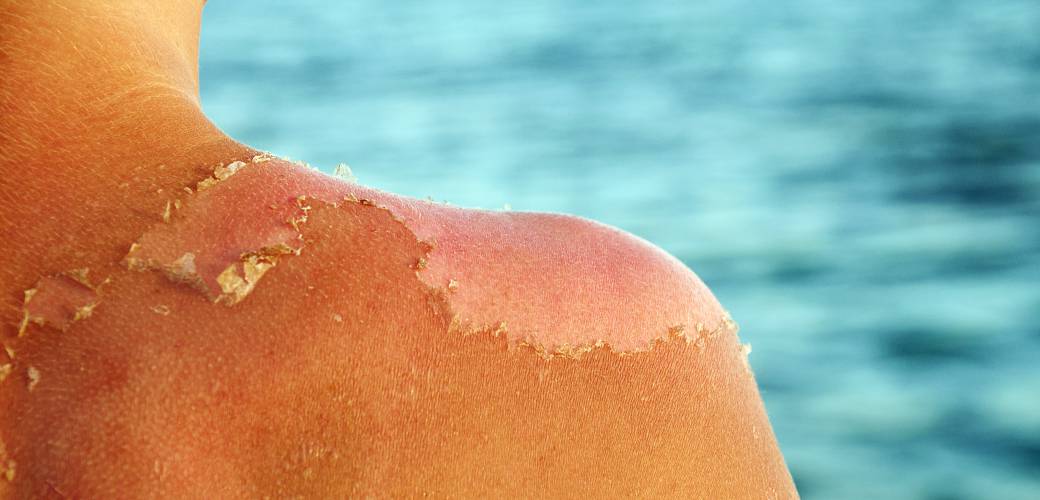
Sunscreen helps prevent skin cancer by providing protection against the harmful effects of ultraviolet (UV) radiation from the sun. UV radiation is a known carcinogen, and prolonged exposure to UV rays can lead to DNA damage in skin cells, increasing the risk of skin cancer. Sunscreen works as a barrier that absorbs, reflects, or scatters UV radiation, thereby reducing its impact on the skin. Here's how sunscreen helps prevent skin cancer:
-
Absorption of UV Radiation:
- Chemical (organic) filters in sunscreen absorb UV radiation and convert it into harmless heat, preventing it from penetrating the skin.
-
Reflection and Scattering:
- Physical (inorganic or mineral) filters in sunscreen, such as zinc oxide and titanium dioxide, act as a barrier that reflects and scatters UV radiation away from the skin. This physical barrier prevents UV rays from reaching the deeper layers of the skin.
-
Prevention of DNA Damage:
- UV radiation can cause damage to the DNA in skin cells. This damage can lead to mutations that contribute to the development of skin cancer. Sunscreen helps reduce the amount of UV radiation that reaches the DNA in skin cells, thereby minimizing the risk of DNA damage.
-
Protection Against UVA and UVB Rays:
- Sunscreen that provides broad-spectrum protection is effective against both UVA and UVB rays. UVA rays contribute to premature aging and are associated with an increased risk of skin cancer, while UVB rays are the primary cause of sunburn and also contribute to skin cancer. Broad-spectrum sunscreens protect against both types of radiation.
-
Prevention of Sunburn:
- Sunburn is a visible sign of skin damage caused by UV radiation. Sunscreen helps prevent sunburn, reducing the immediate impact of UV exposure on the skin.
-
Reduced Risk of Actinic Keratosis:
- Actinic keratosis is a precancerous skin condition caused by prolonged sun exposure. Regular use of sunscreen can reduce the risk of developing actinic keratosis and, consequently, lower the risk of skin cancer.
It's important to note that while sunscreen is a crucial component of sun protection, it should be used in conjunction with other measures such as seeking shade, wearing protective clothing, and avoiding excessive sun exposure, especially during peak hours. Regular skin checks, self-examinations, and professional dermatological evaluations are also important for early detection and prevention of skin cancer.
Sunblock for Oily Skin - Sunblock in Pakistan



